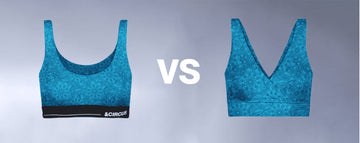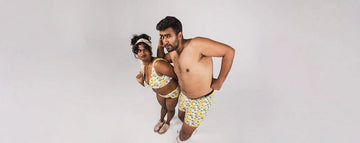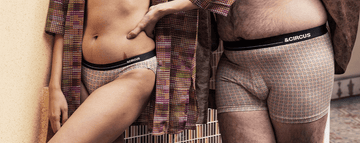In an era where the clothes we wear closest to our skin carry the weight of personal identity and planetary responsibility, innerwear has emerged from the shadows of obscurity into the spotlight of cultural conversation. What was once dismissed as mere functionality now embodies the profound societal pivots toward body positivity, environmental stewardship, and unapologetic diversity. This transformation isn't fleeting; it's a testament to how everyday essentials are reshaping industries and ideologies alike.
Uncomfortable underwear shouldn't steal your confidence. At Andcircus, we craft ultra-soft, sustainable Lenzing Modal Micro® innerwear for every body, XS to 5XL. From briefs to bras, our custom packs fit you perfectly. Shop risk-free with our 100% satisfaction guarantee and embrace comfort that includes everyone. #LoveEveryBody. Shop Now!
Inclusive Innerwear: A Growing Trend Shaping Fashion and Society
The innerwear sector, long overshadowed by outerwear's glamour, is undergoing a renaissance fueled by discerning consumers who refuse to compromise on ethics or fit. At the vanguard stands AndCircus, a brand that seamlessly blends size inclusivity with sustainable innovation, proving that underwear can be both a comfort staple and a catalyst for change. This surge is no anomaly. The global innerwear market, valued at USD 203.72 billion in 2022, is on track to swell to USD 310.02 billion by 2030, propelled by a compound annual growth rate (CAGR) of 5.4% from 2023 onward. These figures, drawn from rigorous trend analyses and market forecasts, underscore a pivotal shift: shoppers are prioritizing products that mirror their values, from expansive sizing to eco-friendly fabrics.
Delve deeper, and the data reveals a market maturing in sophistication. Bottom innerwear, commanding over 50% of revenues in 2022, remains dominant, yet segments like thermals and base layers are accelerating at a projected 7.0% CAGR through the decade. Women's innerwear, holding more than 60% market share, is expanding at 5.8% annually, thanks to designs emphasizing comfort and broad accessibility. Meanwhile, the online distribution channel is outpacing traditional retail with a 7.5% CAGR, as e-commerce democratizes access to diverse options. Regionally, Asia Pacific leads with over 40% share and 6.1% growth, buoyed by rising incomes, while Europe's 25.4% stake reflects a cultural embrace of body positivity. This isn't mere expansion; it's a reconfiguration of fashion's foundational layer, where inclusivity drives not just sales but societal dialogue.
AndCircus exemplifies this ethos. By prioritizing organic cotton and bamboo materials that align with the market's tilt toward sustainability, where cotton still reigns with over 50% share but polyester surges at 6.5% CAGR the brand crafts pieces that feel empowering. Their collections transcend standard sizing, incorporating adjustable features and stretchable textiles to accommodate varied body types. This approach resonates profoundly in a landscape where consumers seek authenticity over artifice, transforming a private purchase into a public proclamation of self-acceptance.
Trends Redefining the Underpinnings of Fashion
At the heart of this evolution lies an unyielding commitment to diversity in form and function. The era of "one-size-fits-most" has mercifully concluded, replaced by extended ranges spanning petite to plus sizes. Brands now engineer underwear with adjustable waistbands, elastic innovations, and bespoke fits, ensuring that comfort is as individualized as fingerprints. This inclusivity isn't performative; it's responsive to a groundswell of body positivity movements that have permeated global consciousness, encouraging wearers to embrace their contours without caveat.
Sustainability, too, has woven itself indelibly into the fabric pun intended of modern innerwear. Eco-conscious materials like organic cotton, recycled polyester, and bamboo viscose are surging in adoption, offering not only reduced environmental footprints but superior tactility: softer against the skin, more breathable in heat, and resilient over time. While the market's material data highlights cotton's enduring lead, the rapid ascent of polyester signals a pragmatic pivot toward synthetics derived from recycled sources. For eco-aware buyers, this means underwear that performs without penance, aligning personal indulgence with planetary preservation. AndCircus leads here, sourcing fibers that minimize waste and water use, proving that green choices needn't compromise on luxury.
Innovation extends beyond materials into the realm of smart textiles, where functionality meets futurism. Moisture-wicking fabrics that regulate temperature ideal for the urban grind or athletic pursuits are now commonplace, often integrated with recycled elements to maintain sustainability credentials. Envision undergarments that adapt to your body's rhythms, cooling in sweltering subways or insulating against winter chills, all while eschewing the environmental toll of virgin polymers. Such advancements, as market projections indicate, are key to the thermals segment's robust growth, blending utility with understated elegance. These aren't gadgets disguised as garments; they're evolutions that elevate the everyday, making innerwear a silent ally in life's demands.
Yet, these trends are regionally nuanced. In Asia Pacific's bustling markets, where growth hits 6.1%, affordability meets aspiration, with brands scaling inclusive lines to tap emerging middle classes. Europe's fashion-forward ethos, meanwhile, amplifies diverse beauty standards, fostering designs that celebrate rather than constrain. Globally, the online boom growing at 7.5% empowers niche players like AndCircus to reach far-flung audiences, bypassing brick-and-mortar biases toward standardized sizes.
Real-World Ripples: AndCircus and Industry Pioneers
AndCircus isn't just participating in this wave; it's cresting it. Their size-spanning collections, coupled with a sustainable core, have elicited effusive feedback. Wearers rave about the liberating fit and ethical backbone, with one likening their briefs to "a planetary hug in fabric form." This isn't hyperbole; it's the payoff of deliberate design that honors diverse identities, from gender-fluid options to adaptive features for mobility needs. In a market where women's segments dominate yet demand more nuance, AndCircus delivers, fostering loyalty that translates to repeat business and word-of-mouth evangelism.
The ripple effect extends industry-wide. Titans like Savage X Fenty have revolutionized inclusivity through star-powered campaigns showcasing real bodies in real sizes, while ThirdLove champions customizable bras that defy cookie-cutter molds. Smaller innovators, too, are allying with ethical suppliers recycled fiber mills and organic farms to birth lines that prioritize equity and ecology. These partnerships transcend profit; they forge ecosystems where collaboration catalyzes progress. Consider AndCircus's ties to sustainable weavers: such alliances not only slash costs over time but sculpt a supply chain resilient against resource scarcity, echoing the market's broader pivot toward circular economies.
Consumer stories amplify this impact. In forums and reviews, voices from underrepresented sizes share tales of newfound confidence, crediting inclusive innerwear for bridging the gap between aspiration and reality. This empowerment loops back to sales: as the women's category grows at 5.8%, brands attuned to these narratives capture not just market share but cultural currency, positioning themselves as stewards of change.
Navigating the Hurdles of Inclusive Innovation
For all its promise, the path to inclusive innerwear is strewn with obstacles that test even the most resolute brands. Foremost is enlightening consumers long conditioned to equate sustainability with sacrifice. The perception lingers that eco-materials inflate prices or dull aesthetics, a myth AndCircus combats through transparent storytelling and accessible pricing. Yet, shifting mindsets demands persistent education campaigns demystifying organic cotton's premium (rooted in ethical farming) without alienating budget-conscious buyers.
Supply chain complexities compound the challenge. Scaling sustainable sourcing while upholding quality is Herculean: organic variants cost more upfront, recycled processing demands precision, and inclusive prototyping multiplies iterations. In a market where polyester's 6.5% CAGR tempts cost-cutting, purists like AndCircus must innovate efficiencies perhaps through vertical integration to safeguard margins. Smaller outfits, especially, grapple with this calculus, where ballooning production expenses threaten viability amid offline channel's 76.6% dominance, which favors volume over variety.
Stylistic equilibrium poses yet another tightrope. Inclusivity must harmonize with trends, lest it veer into blandness. Designers juggle vibrant patterns and cuts that flatter all forms without alienating fashionistas, a feat requiring ceaseless R&D. Europe's body-positive ethos aids here, but globally, brands must anticipate runway ripples while grounding in wearability ensuring that trendy thermals, growing at 7%, don't forsake the plus-size patron.
Unlocking Horizons: Growth and Strategic Imperatives
These trials, however, pale against the vistas of opportunity. Inclusive innerwear isn't a niche; it's a nexus for enduring allegiance. Brands attuning to diverse demographics evident in the women's 60% stronghold cultivate devotees who return, evangelize, and amplify. As Grand View Research forecasts a 5.4% CAGR to 2030, this loyalty propels share gains, particularly online where 7.5% growth favors agile entrants like AndCircus.
The CSR halo gleams brighter still. Committing to green practices and broad sizing burnishes reputations, swaying ethics-driven millennials and Gen Z, who weave values into wallets. A brand's virtuous stance mirroring Europe's diverse standards yields premiums, with purpose-fueled purchases surging amid Asia Pacific's 6.1% ascent. AndCircus harnesses this, their eco-ethos not mere branding but bedrock, yielding dividends in trust and turnover.
Business models evolve apace: subscriptions for seamless replenishment, made-to-order for zero waste, and co-ventures with green mills for scalable impact. These stratagems slash inefficiencies, engage via personalization, and fortify against volatility transforming inclusivity from ideal to imperative, a shrewd calculus in a USD 310 billion horizon.
Vision Forward: Innerwear as Cultural Compass
Reflecting on innerwear's ascent, one marvels at its metaphoric might: a garment so intimate yet so illustrative of our collective metamorphosis. From the USD 203.72 billion baseline of 2022 to the projected USD 310.02 billion pinnacle, this market chronicles a society's stride toward equity and ecology. AndCircus, with its trailblazing tapestry of sizes and sustainability, doesn't merely mirror this; it magnifies it, urging an industry to evolve beyond commerce into conscience.
The trajectory is luminous. As consumers clamor for more spanning segments, regions, and realities brands must heed: innovate inclusively, sustain boldly, defy conventions. For in crafting underlayers that embrace every silhouette and scruple, they don't peddle fabric; they pioneer paradigms. This is fashion's quiet revolution, a slip-on shift worth every seam.
Frequently Asked Questions
What is driving the growth in the inclusive innerwear market?
The inclusive innerwear market is being driven by consumers who prioritize body positivity, sustainability, and diverse sizing options. With the global innerwear market projected to grow from $203.72 billion in 2022 to $310.02 billion by 2030 at a 5.4% CAGR, shoppers are increasingly choosing products that reflect their values, from extended size ranges to eco-friendly materials like organic cotton and bamboo.
How are sustainable materials changing the underwear industry?
Sustainable materials like organic cotton, recycled polyester, and bamboo viscose are revolutionizing innerwear by offering superior comfort while reducing environmental impact. These eco-conscious fabrics are softer against the skin, more breathable, and resilient over time, proving that environmentally responsible choices don't require compromising on luxury or performance.
What makes AndCircus different from traditional innerwear brands?
AndCircus stands out by seamlessly blending size inclusivity with sustainable innovation, offering collections that transcend standard sizing through adjustable features and stretchable textiles. The brand prioritizes organic cotton and bamboo materials while creating gender-fluid options and adaptive features for diverse body types, transforming innerwear from a private purchase into a statement of self-acceptance and environmental responsibility.
Disclaimer: The above helpful resources content contains personal opinions and experiences. The information provided is for general knowledge and does not constitute professional advice.
You may also be interested in: Beyond the Fabric: Debunking the Myth of Clothing in Sexual Assault
Uncomfortable underwear shouldn't steal your confidence. At Andcircus, we craft ultra-soft, sustainable Lenzing Micro Modal innerwear for every body, XS to 5XL. From briefs to bras, our custom packs fit you perfectly. Shop risk-free with our 100% satisfaction guarantee and embrace comfort that includes everyone. #LoveEveryBody. Shop Now!







































